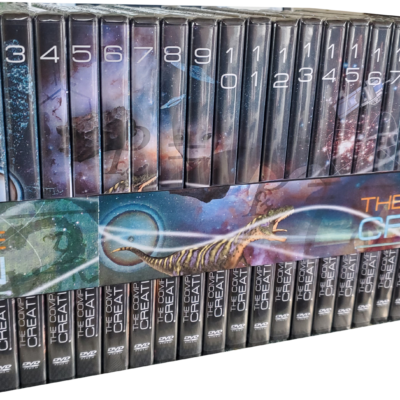by Ian Juby | May 19, 2015 | Research
Fossils are surprisingly common in the Ottawa Valley and often very easy to get, you just need to know where and how to look. Rock cuts are fabulous places to check, and especially along highway 17 right beside the Muskrat river at the bottom of Meath hill there are several fabulous limestone rock cuts that are just plastered with fossils. Check it out and see if you can find the fossilized Coral Reef in the rock cut – then ask yourself a question: “How did this Coral Reef get here?”
There is no ocean for quite a few many miles from this site, yet here is coral. Leftovers from a global flood perhaps?
The shoulder of a busy highway is a LOUSY place to do a fossil hunt with a family. I am looking for someone in the Pembroke area who might be willing to host a family fun-dig for fossils. All you need is a limestone shelf. If you have rock on your property that looks something the colour of concrete, you probably have limestone. A small cliff would be perfect, or a really secluded rock cut is by far the best.
For more information or to volunteer your limestone shelf, drop me an email at ianjuby[@]ianjuby.org (removest though the [ ]’s)
by Ian Juby | May 19, 2015 | Research
Currently, we as human beings are stressed out (gee, it takes a genius to figure that one out). Here’s why: Looking at diagram #1, you see a schematic diagram of the synopses of our nerves. There is currently a gap in each synapse which must be jumped electrically for our nerve signals to reach the brain, or transmit within the brain.
When you look at pink, (specifically in the shade of magenta), your brain secretes a substance called norepineferin, a neurotransmitter. This substance travels down the nerve cells, crossing the gap in our synopses allowing for much freer neurotransmission. The end result is faster mental capabilities and relaxation. It also can have serious impact on depression, ADD, and a host of other disorders.
There are several experiments that can be conducted:
-the effects of pink on neurotransmission based on mathematical ability
-the effects of pink on ADD, depression, and other mental / emotional disorders
-the effects of pink on plant growth
The effects of pink on neurotransmission
A simple experiment to conduct, a specific age group (such as younger children) with a wide assortment of “guinea pigs” is tested with some simpler to slightly complex math questions. Several different types of math sheets with various forms and complexities of math questions should be used. Several subjects should be tested on the sheets to determine average results of how long it takes to complete the sheet and how accurate the average individual answers the questions. These results would be your comparison results.
The next phase of the experiment is conducted in much the same manner except the tested subjects are either wearing pink tinted glasses, working in a pink environment (such as a small room with pink tinted windows), or even possibly just using pink paper (the neon pink paper works best) to print the math questions on.
The results are compared with the non-pink environment results to determine any effect.
As you can imagine, the hardest part is merely coming up with math questions of similar complexity, the rest is just footwork and organisation. In one very crude form of this experiment I conducted a couple of years ago, I was nothing less than stunned by the results. I do recall one girl cutting her math time to one eighth her original time for complex math questions.
If you are interested in conducting this experiment or one like it, e-mail me and I’ll give more detailed suggestions or may even be able to provide some math question sheets for the experiment to save space on this web page.
To study the effects of pink on ADD, depression, and other mental or emotional disorders:
It would be preferred that a professional phsychologist perform this kind of study, but if you’re interested, e-mail me and can provide some suggestions.
I can’t divulge details and I’d certainly not encourage anyone to do what I did (You had to have been there, I was desperate and had almost no options), but I personally used a different technique of triggering norepineferin production by a change in diet, and wound up watching it correct extreme schizophrenic halucinations in a friend of mine – within 6 hours! I was so caught up in the stress at the time I didn’t realize it worked until two days later.
Anyways, if you are a researching psychologist or psychiatrist interested in doing studies in this area (or have already – let me know the results please!), or you suffer from things like ADD or dyslexia and wish to experiment with the effects of pink light, e-mail me and I can give you more details. I really wouldn’t recommend experimenting without professional guidance of some kind though.
To study the effects of pink light on plants
Apparently botanists have found that plants grow best under pink light. I’d like to verify that by experimentation on numerous types of plants. There are other methods of plant growth encouragement I’d like to incorporate as well.
The experiment is simple; using pink plexiglass or plastic, shield your plant from normal light and allow it to experience lots of or only pink light. Have a second plant in the exact same environment but in regular light. Watch them grow! E-mail me and let me know how your experiment went!
by Ian Juby | Mar 27, 2015 | Research
If time has been considerably shorter than previously thought, and according to Frederick B. Juneman1, “events that brought the Mesazoic (the age of the dinosaurs – IJ) to a close may be in the age and memory of man”, then the possibility that dinosaurs might still be alive on planet earth should be seriously looked at.
It may seem far fetched at first, but remember that only a few hundred years ago we have specific documentation of “dragons” in Europe2.
Dr. Javier Cabrera3 has a collection of burial stones retrieved from the Incan tombs of Peru showing creatures abiding with mankind which look very distinctly like dinosaurs. These stones date only 500 to 1500 years old.
A UPI report of October 1980 said “a mysterious, elephant sized animal with claws, a long neck, and tail seen in the swampy jungles of Western Africa may be a dinosaur, an expert on ‘hidden animals’ said Tuesday.”
Roy Mackal was mentioned as having led an expedition in response to previous similar reports of mysterious creatures in the Congos:
“Roy Mackal of the University of Chicago claimed that the inhabitants of a remote section of the Congo refer to the 15 to 30 foot long creature as ‘Mokele Mbembe’, and he suggested it might be either a dinosaur or a large monitor lizard. He had spent some time with James Powell in the region, searching for conclusive evidence.
“The natives described the creatures, including the statement that their three-clawed feet were as large as frying pans. Pictures of known animals such as the Buffalo and elephant were shown to them without attracting much interest, but ‘when they saw a picture of the brontosaurus, or any of the sauropods, they pointed at it and called it ‘Mokele Mbembe’.
“The response of the natives was consistent and ‘cut across ethnic, geographical, cultural, and educational lines.'”
In the same report, it quoted “Science 80 magazine, published by the American Association for the Advancement of Science said… that the creatures reportedly feed on the nut-like fruit of the river bank plant and keep to deep pools and submerged caves in the area.” 1959: “Pygmies allegedly killed one that was disturbing their fishing on Lake Tele.”
Still yet another report in 1981 was published by science writer Robert Locke, June 11 that said “The creature had been described by the natives as brownish-grey, with short, thick legs, weighing probably between 9 to 15 tons, and being about 35 feet from its small head to its tail. It was vegetarian, and though it had killed fishermen it had not eaten them.
“It would at times emerge from the water in the early morning and the late evenings to feed on Riverside vegetation; for the rest of the time it stayed in the water, much like the hippopotomus.”
A three month search was being organized by consultant engineer Herman Regusters (Jet Propulsion Labs, NASA) together with Biologist Roy P. Mackal (U of Chicago) and Botonist Richard Greenwell of the U of Arizona.
A later report by Dick Donovan documented TWO independent scientific expeditions offering proof that dinosaurs still prowled the earth.
“Space scientist Herman Regusters astounded the world by announcing he saw a gigantic dinosaur when his expedition probed the jungles of Africa.”4
He also tells of the second expedition, sponsored in part by the National Geographic Society;
“And respected University Professor Roy Mackal says his expedition found the fresh footprints of a dinosaur that weighed in at 30 tons”…”I was the tracks with my own eyes!”, Dr. Mackal said. “I am more convinced than ever that the giant reptiles still exist.”
Regusters expedition reported sighting a creature that raised its head up out of the water and travelled for a quarter of a mile then dove beneath the surface. They sighted it again four hours later.
Dr. Carl Baugh, Creation Evidences Museum, Glen Rose, Texas led an expedition to New Guinea in response to reports of flying Pterodoctyls. They searched themselves and although had no personal encounters, documented interviews with the locals, including teachers, heads of clan, etc., which claim to have seen or had encounters with these strange flying creatures which describe remarkably like Ramphorhynchus Pterydoctyl and apparently glow in the dark on their underside, much like the firefly.5
Reader Digest magazine documented over 250 lakes in the United States and Canada which have supposed “monsters” in them. What if these were actual encounters with dinosaurs still alive in Canadian and American waters? Really the only reason people are skeptical of that possibility is that we have been led to believe that dinosaurs have been extinct for 60 million years or so, yet as shown elswhere on these web pages, there is absolutely no reason to believe this.
Cobden, Ontario, is located on the shores of the Muskrat Lake. This lake is one of many in North America which people have claimed to have seen a strange, unidentifiable creature in. The descriptions could resemble that of a Mosasaur, a marine based dinosaur of which a few skeletons have been found.
In an attempt to determine if there is something alive in Muskrat Lake, possibly even capturing or photographing one, I have undertaken to search the Lake and am currently looking for volunteers to participate. The search is broken up into several stages:
Stage 1: A scan of the lake is done with numerous boats armed with fish finders. We will start at one end of the lake and forming a line across the lake will drive to the far end of the lake, noting any unusual “hits” on the fish finder with a camera and personal notes on depth, location, time, etc…
We will turn around and complete the pass back to the start, performing the same scan of the lake.
Stage 2: Depending on how the scan turns out, a second or even third scan may be performed to see if there are any hits or a pattern of hits emerging.
Stage 3: Determined by the scans, if we have several successful hits on sonar, we will attempt to locate the creature or at least determine its patterns. From here on in there are several options, all or one of which may be attempted:
-further complete lake or specific location scans
-sound capture and sampling
-diving robot with video cameras
-underwater cameras “flown” behind a boat
-a cage live trap
-sonar triggered photograph traps
-possible tagging with radio transmitters
-scuba dive investigating (anybody feel brave?)
-mini submarine dives?
The difficulty lies in the lack of visibility in the Lake. I had done a few dives with a submarine robot and several swimming dives with a mask. In spring time when the water is cold and visibility is best I’d estimate we’d have a visibility of a maximum of 20 feet. In the fall with the algae in the water it’s probably more like around 5 foot visibility. Fortunately, sonar can see through pretty much all of the muck so we can get some pretty good scans with that technique. The problems with baiting and live capture run from not having the foggiest clue what this thing would eat, should it turn out to exist, and the possibility that it breathes air – or water. If it breathes air, trapping it in the water could hold it underwater for too long. If it breathes water, even a few moments out of the water could kill it. We would have no idea until we caught one.
It has been suggested by “Mussie” (the pet name locals have for the Muskrat Lake monster) buffs that the creature doesn’t like boat motors and shies away from them. This would encourage the use of “flying” underwater video cameras and diving robots as they don’t need a motor boat, or at least a quieter electric one. Sonar triggered photo traps would also work well, as they produce no noise – only a flash of light when triggered.
Interested? Learn more or let me know you want to volunteer here!
References:
1: Frederick B. Juneman, Vol 24, 1982, Industrial Research & Development
2: Ulysses Aldrovandus, THE NATURAL HISTORY OF SERPENTS AND DRAGONS
Helen L. Hoke, DRAGONS, DRAGONS, DRAGONS
Konrad Gesner, HISTORIAE ANIMALIUM
3: Dr. Javier Cabrera, previously professor of medicine, University of Lima, Currently cultural Anthropologist for ICA, Peru. Dr. Cabrera has collected over 1100 of these burial stones.
4: Frank C. Hibbern, “The Lost Americans” pp 90-92
5: Personal communication, Dr. Carl Baugh & M.E. Clark, Professor emeritus, University of Illinois. Also cited in “Creation in Symphony” video produced by the Creation Evidences Museum.



